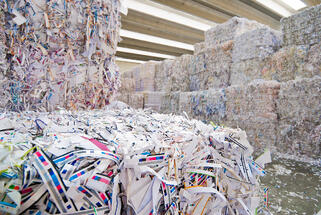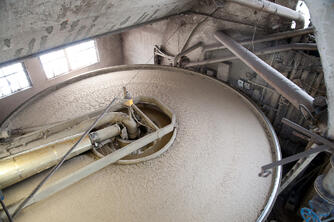Have you ever wondered how much paper we recycle as Americans? The answer is half.
Although it’s sometimes overlooked, paper is used for far more than just writing materials. It’s used for tissues, disposable kitchen items (such as plates, bowls, and cups) and is also used for cardboard boxes and tubes. With this diverse array of potential items that can be made from paper, paper producers must have an efficient system to keep this cycle going.
 In the same way that hay and grain producers, or building inspectors must constantly be cognizant of the moisture content of the materials they work with, the same certainly goes for paper producers. Throughout every part of the production process, it’s crucial to be aware of how much water is in the product and that’s done — as you probably guessed — by using moisture meters.
In the same way that hay and grain producers, or building inspectors must constantly be cognizant of the moisture content of the materials they work with, the same certainly goes for paper producers. Throughout every part of the production process, it’s crucial to be aware of how much water is in the product and that’s done — as you probably guessed — by using moisture meters.
Some paper moisture meters use contact pins and the property of electrical resistance to measure the moisture content of paper pulp. These meters are highly useful for manual inspections of paper products. However, there are other types of electrodes that can be used for measuring the moisture content of paper.
Rather than use pins to test the moisture content of paper pulp on the wire in the paper-making process, some paper moisture meters use special electrodes with rolling contact heads (such as Delmhorst's 12-E electrode). These special contact heads allow the meter to get a reading of the moisture content of paper pulp on the wire without having to stop production.
If there is too much water in paper pulp as it is being put through a given process, the paper may fall apart.
The importance of measuring the %MC in paper extends to the fact that moisture can affect the efficacy of the equipment that’s involved in the paper-making process.
Measuring Moisture In Pulp & Paper
Due to the fact that moisture in paper can be a make-or-break factor in the product’s final quality, the use of technology to ensure proper moisture levels is highly valued. Delmhorst has two paper moisture meters: the RDM-3P and the P-2000.
These moisture meters make direct contact with the various kinds of material that it’s suited for including paperboard, corrugated stock and paper tubes, and have three different scales for more unique moisture measurements.
 Keep Your Paper Moisture Perfect
Keep Your Paper Moisture Perfect
There are also other non-portable moisture meters that can be used to measure moisture in paper and wood products. Furthermore, to keep your current paper product at the optimum moisture content, there are some precautions you can take.
For instance, when a paper shipment comes in, the placement of the delivery should be taken into account. Paper should be given time to acclimate to the environment’s temperature, especially if it is being unwrapped here.
To maintain a consistent temperature, it’s also recommended that paper not be stationed in an area where a heater or cooling unit is nearby, as these devices may interfere with the paper’s acclimation process. In the process of paper production, the packaged paper should be kept wrapped until the moment that it has to be processed — not left out for hours.
Finally, the use of vapor-proof wrappers is highly recommended. Using these wrappers between the steps of paper production helps the paper to remain tightly-knit and fresh while keeping out the excess, unwanted moisture away from the final product.
To determine which moisture meter best suits your moisture measuring needs with your paper products, feel free to browse our moisture meters or contact us for any additional advice!
And, remember, keep recycyling!

Comments